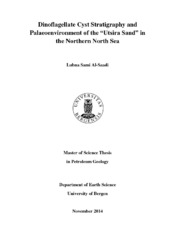Dinoflagellate cyst stratigraphy and palaeoenvironment of the "Utsira Sand" in the northern North Sea
Master thesis
Permanent lenke
https://hdl.handle.net/1956/9205Utgivelsesdato
2014-11-20Metadata
Vis full innførselSamlinger
- Department of Earth Science [1050]
Sammendrag
Safe CO_2 storage in the Utsira Formation is one of many solutions to climate change mitigation. A major leakage had occurred in the Utsira Formation in 2008, due to water injection in what was believed to be the Utsira Formation. Studies indicated that the rock formation for injection of produced water was not appropriate, and this reflected poor understanding of the stratigraphy of the Tampen area (North Sea). Thirteen palynological samples between 1125.65 and 1141.65 m of well 34/8-A-33H in the Tampen area, northern North Sea have been studied in order to understand the stratigraphy and provide information on age and palaeoenvironment. The studied interval is mapped as the Utsira Formation. The investigated interval was dated to 2.6 -3.7 Ma (late Pliocene) based on dinoflagellate cysts and acritarchs, such as Operculodinium? eirikianum, Operculodinium centrocarpum, Bitectatodinium raedwaldii, Lingulodinium machaerophorum, Cymatiosphaera? invaginata and Lavradosphaera crista which were correlated to stratigraphic ranges from reference sections in the North Atlantic Sea and adjacent seas. The absence of typical early Pliocene species (Batiacasphaera minuta, Corrudinium devemaliae, Echinidinium euaxum, Operculodinium tegillatum, Pyxidinopsis vesiculata, Bitectatodinium serratum and Reticulatosphaera actinocoronata) in the studied interval supports this conclusion. According to the marine dinoflagellate cysts and terrestrial palynomorphs (pollen and spores), and depending on palaeoenvironmental indices (Sporomorph / Dinoflagellate cyst index, Warm / Cold index, Inner neritic / Oceanic, Outer neritic / Oceanic, Neritic /Oceanic and Inner neritic / Outer neritic index, Gonyaulacoid / Protoperidinioid index), the palaeoenvironment is shown to be an outer neritic setting with warm to temperate conditions. The studied interval well 15/9-A23 (Piasecki et al., 2002) was estimated to be early Pliocene, and the core dinoflagellate cyst assemblages indicated outer shelf deposition under cool climate. The Nordland Group mudstone, well 15/9-A-11 (Head et al., 2004) was considered to be Gelasian (early Pleistocene) in age, with outer neritic environment, deposited under cool conditions. By comparison the estimated age in this study (well 34/8-A-33H), is considered to be younger than the age in well 15/9-A23 (Piasecki et al., 2002) and older than the age in well 15/9-A-11 (Head et al., 2004). Therefore the studied interval in this study is believed to be representing the uppermost part of the Utsira Formation.
